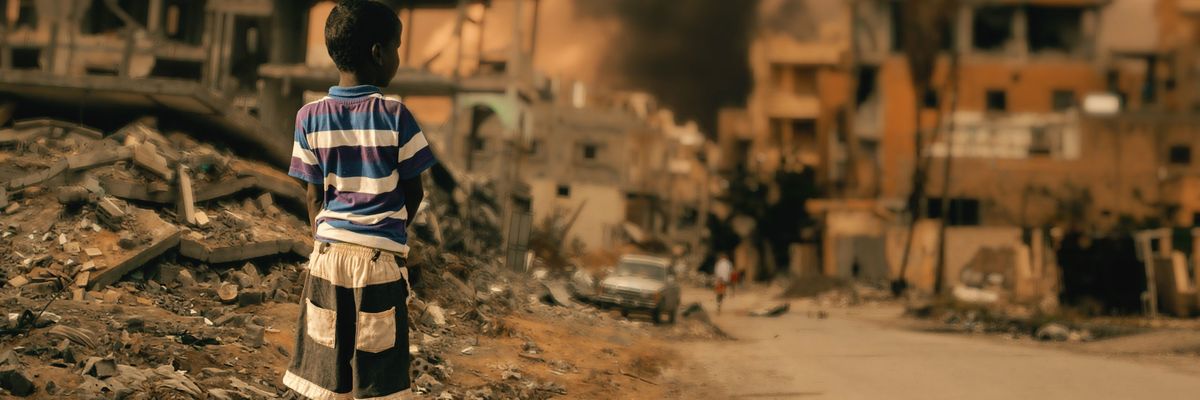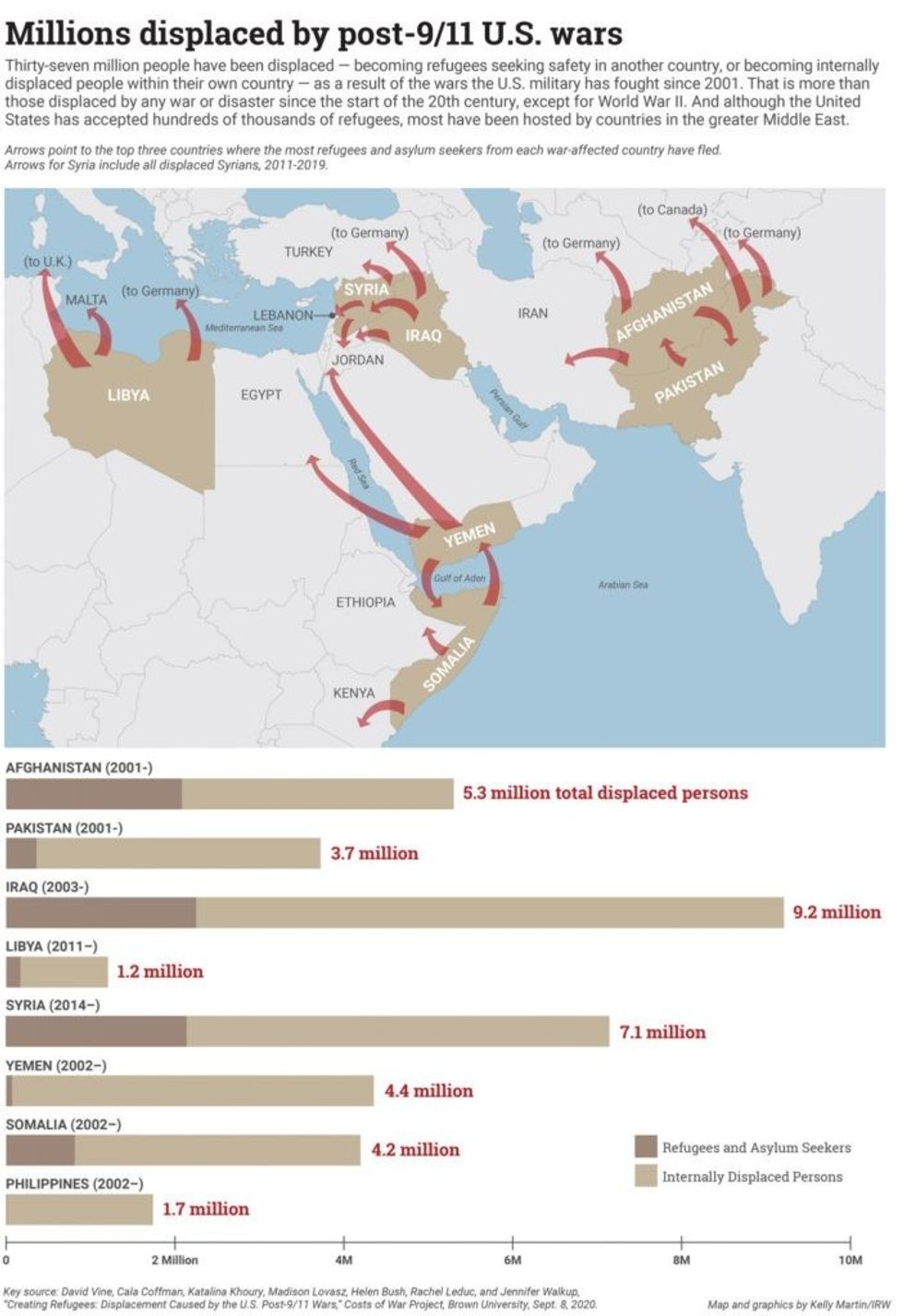This article was republished with permission from The Investigative Reporting Workshop.
The wars the U.S. government has fought since the attacks of Sept. 11, 2001, have forced 37 million people — and perhaps as many as 59 million — from their homes, according to a newly released report from American University and Brown University’s Costs of War Project.
Until now, no one has known how many people the wars have displaced. Indeed, most Americans are likely unaware that U.S. combat operations have taken place not only in Afghanistan, Iraq and Syria, but also in 21 other nations since President George W. Bush announced a global war on terror.
Neither the Pentagon, the State Department nor any other part of the U.S. government has tracked the displacement. Scholars and international organizations, such as the United Nations refugee agency, UNHCR, have provided some data about refugees and internally displaced people (IDPs) for individual countries at war. But this data offers point-in-time counts rather than the cumulative number of people displaced since the wars started.
In the first calculation of its kind, American University’s Public Anthropology Clinic conservatively estimates that the eight most violent wars the U.S. military has launched or participated in since 2001 — in Afghanistan, Iraq, Libya, Pakistan, the Philippines, Somalia, Syria and Yemen — have produced 8 million refugees and asylum seekers and 29 million internally displaced people.
The estimated 37 million displaced is more than those displaced by any war or disaster since at least 1900, except for World War II, when 30 million to 64 million or more people fled their homes. Thirty-seven million exceeds those displaced during World War I (approximately 10 million), the partition of India and Pakistan (14 million) and the U.S. war in Vietnam (13 million).
Displacing 37 million people is equivalent to removing nearly all the residents of the state of California or all the people in Texas and Virginia combined. The figure is almost as large as the population of Canada. The United States’ post-9/11 wars have played an overlooked role in fueling the near-doubling of refugees and internally displaced people globally between 2010 and 2019, from 41 million to 79.5 million.
Millions have fled air strikes, bombings, artillery fire, house raids, drone attacks, gun battles and rape. People have escaped the destruction of their homes, neighborhoods, hospitals, schools, jobs and local food and water sources. They have fled forced evictions, death threats and large-scale ethnic cleansing set off by the U.S. wars in Afghanistan and Iraq in particular.
The U.S. government is not solely responsible for displacing 37 million people; the Taliban, Iraqi Sunni and Shia militias, Al-Qaida, the Islamic State group and other governments, combatants and actors also bear responsibility.
Pre-existing conditions of poverty, global warming-induced environmental change and other violence have contributed to driving people from their homes. However, the eight wars in the AU study are ones the U.S. government bears responsibility for initiating, for escalating as a major combatant or for fueling, through drone strikes, battlefield advising, logistical support, arms sales and other aid.
Specifically, the Public Anthropology Clinic estimates the displacement of:
- 5.3 million Afghans (representing 26% of the pre-war population) since the start of the U.S. war in Afghanistan in 2001;
- 3.7 million Pakistanis (3% of the pre-war population) since the U.S. invasion of Afghanistan in 2001 quickly became a single war crossing the border into northwest Pakistan;
- 1.7 million Filipinos (2%) since the U.S. military joined the Philippine government in its decades-old war with Abu Sayyaf and other insurgent groups in 2002;
- 4.2 million Somalis (46%) since U.S. forces began supporting a UN-recognized Somali government fighting the Islamic Courts Union (ICU) in 2002 and, after 2006, the ICU’s breakaway militia wing Al Shabaab;
-4.4 million Yemenis (24%) since the U.S. government began drone assassinations of alleged terrorists in 2002 and backed a Saudi Arabia-led war against the Houthi movement since 2015;
- 9.2 million Iraqis (37%) since the 2003 U.S.-led invasion and occupation and the post-2014 war against the Islamic State group;
- 1.2 million Libyans (19%) since the U.S. and European governments intervened in the 2011 uprising against Moammar Gadhafi fueling an ongoing civil war;
- 7.1 million Syrians (37%) since the U.S. government began waging war against the Islamic State in 2014.
Most refugees from the wars in the study have fled to neighboring countries in the greater Middle East, especially Turkey, Jordan and Lebanon. About 1 million reached Germany; hundreds of thousands fled to other countries in Europe as well as to the United States. Most Filipinos, Libyans and Yemenis have been displaced within their own countries.
The Public Anthropology Clinic used the most reliable international data available, from the UNHCR, the Internal Displacement Monitoring Centre, the International Organization for Migration and the UN Office for the Coordination of Humanitarian Affairs. Given questions about the accuracy of displacement data in war zones, the calculation methodology was a conservative one.
Statistics for refugees and asylum seekers easily could be 1.5 to 2 times higher than the findings suggest, yielding some 41 million to 45 million people displaced. The 7.1 million Syrians displaced represent only those displaced from five Syrian provinces where U.S. forces have fought and operated since 2014 and the beginning of the U.S. war against the Islamic State in Syria.
A less conservative approach would include the displaced from all of Syria’s provinces since 2014 or as early as 2013 when the U.S. government began backing Syrian rebel groups. This could take the total to between 48 million and 59 million, comparable to the scale of World War II’s displacement.
The clinic’s 37 million estimate is also conservative because it does not include millions displaced during other post-9/11 wars and conflicts involving U.S. forces.
U.S. combat troops, drones strikes and surveillance, military training, arms sales and other pro-government aid have played roles in conflicts in countries including Burkina Faso, Cameroon, Central African Republic, Chad, Democratic Republic of the Congo, Kenya, Mali, Mauritania, Niger, Nigeria, Saudi Arabia (linked to Yemen’s war), South Sudan, Tunisia and Uganda. In Burkina Faso, for example, there were 560,000 internally displaced people by the end of 2019 amid a growing militant insurgency.
The damage inflicted by displacement has been profound across all 24 countries where U.S. troops have deployed. Losing one’s home and community, among other losses, has impoverished people not just economically but also psychologically, socially, culturally and politically. The effects of displacement extend to host communities and countries, which can face burdens hosting refugees and those who have been displaced internally, including increased societal tensions. On the other hand, host societies often benefit from the arrival of displaced people because of greater societal diversity, increased economic activity and international aid.
Of course, displacement is just one facet of war’s destruction.
In Afghanistan, Iraq, Syria, Pakistan and Yemen alone, an estimated 755,000 to 786,000 civilians and combatants have died as a result of combat. An additional 15,000 U.S. military personnel and contractors have died in the post-9/11 wars. Total deaths on all sides in Afghanistan, Iraq, Syria, Pakistan and Yemen may reach 3–4 million or more, including those who have died as a result of disease, hunger and malnutrition caused by the wars. The number of those injured and traumatized extends into the tens of millions.
Ultimately, the harm inflicted by war, including on the 37 million to 59 million displaced, is incalculable. No number, no matter how large, can capture the immensity of the damage suffered.
Key sources: David Vine, The United States of War: A Global History of America’s Endless Conflicts, from Columbus to the Islamic State (Oakland: University of California Press, 2020); David Vine, “Lists of U.S. Military Bases Abroad, 1776-2020,” American University Digital Research Archive; Base Structure Report: Fiscal Year 2018 Baseline; A Summary of the Real Property Inventory Data (Washington, DC: U.S. Department of Defense, 2018); Barbara Salazar Torreon and Sofia Plagakis, Instances of Use of United States Armed Forces Abroad, 1798–2018 (Washington, DC: Congressional Research Service, 2018).
Note: Some bases only occupied for part of 2001–2020. At the height of U.S. wars in Afghanistan and Iraq, there were over 2,000 bases abroad.















